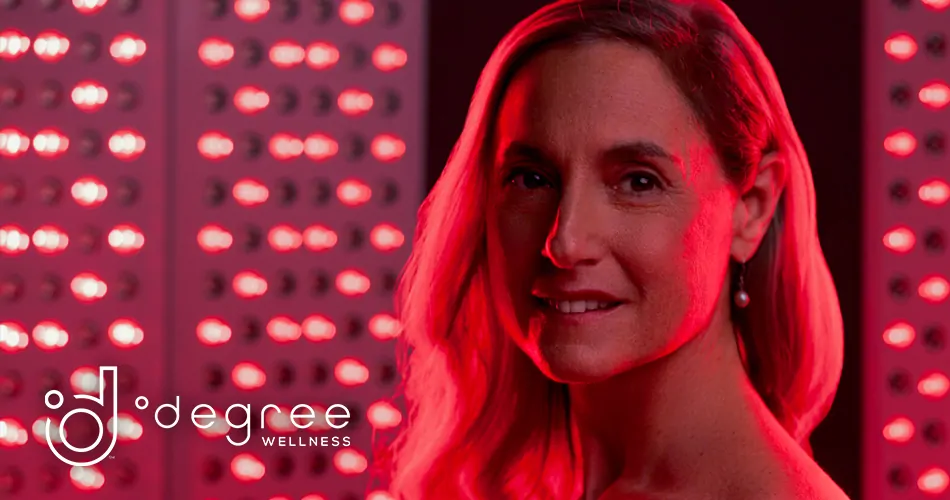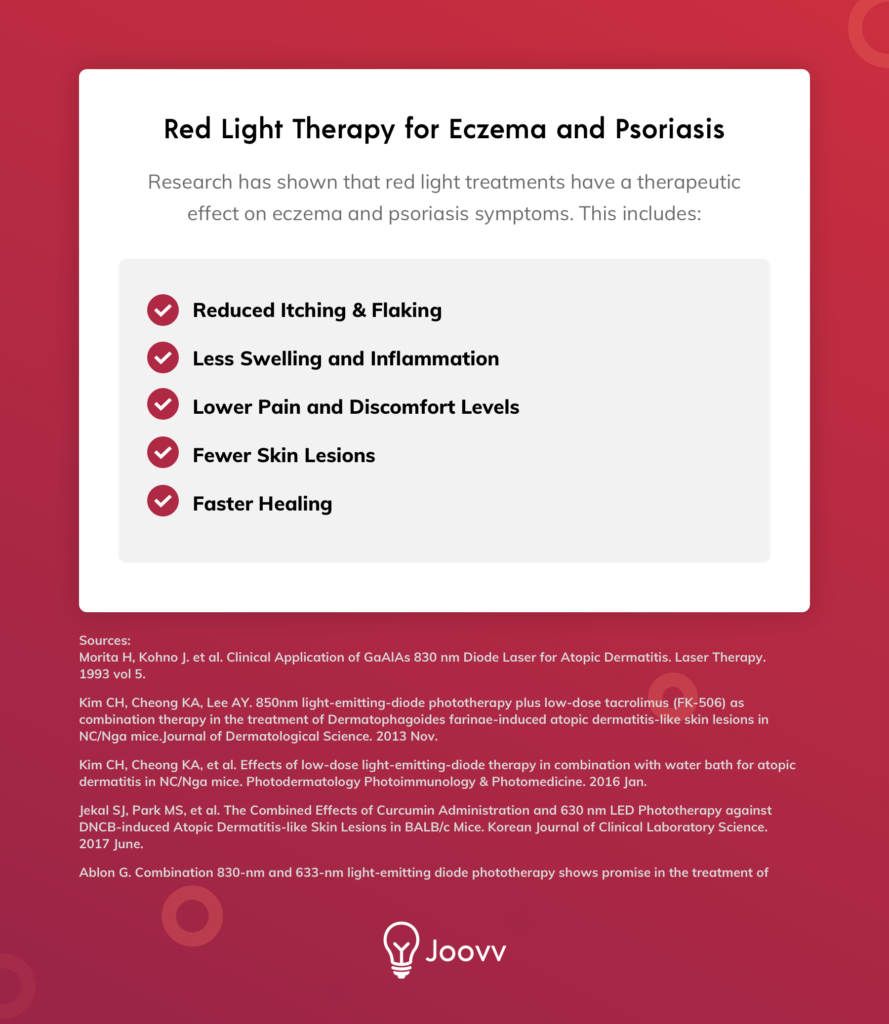Eczema and psoriasis are some of the most common skin conditions, with over 30 million Americans suffering from eczema, and 8 million with some form of psoriasis. [1,2] Unfortunately, treating eczema and psoriasis isn’t well understood and current solutions aren’t very effective.
But in more promising news for people who struggle with these skin conditions, recent clinical results are showing that natural red light therapy can reduce itchiness & redness, improve the appearance of skin rashes & flaking, and decrease inflammation.
This post looks at the positive clinical data that shows how red light therapy can be an effective, non-invasive treatment for eczema and psoriasis, without the risks or side effects of common prescription drugs.
Eczema and Psoriasis Treatment Today is Lacking
Eczema refers to a variety of skin-related conditions, while psoriasis is actually a different and complex autoimmune disease. But they are often grouped together because both cause inflamed, itchy skin that’s difficult to treat. There are no cures for either eczema or psoriasis, so as with most chronic conditions, management of symptoms is central to treatment. Many people use ointments and creams, and/or prescription drugs and anti-allergy meds. These have limited effectiveness, and the medications often come with other unwanted risks and side effects.
Seeking an effective, natural alternative, researchers have conducted peer-reviewed studies on the benefits of red light therapy for people with eczema and psoriasis. The findings are preliminary but very positive, giving reasons for optimism and spurring further research.
Research Shows Red Light Therapy Reduces Itchiness and Swelling from Eczema
In one of the initial human trials analyzing red light and eczema, researchers followed 81 patients for nearly a year, measuring how their symptoms progressed with regular treatments.
The researchers evaluated eczema rashes before, during, and after patients tried red light therapy treatments. People received just one, 2-minute red light therapy session per week. Even with such a short treatment, researchers found considerable improvements in common eczema symptoms, including a reduction in all of the following:
- Gooseflesh-like bumps (follicular keratosis)
- Flaking skin (pityriasis)
- Reddening (erythema)
- Pimples or swelling (papules)
The research team also evaluated itchiness levels before, during, and after red light therapy and found patients picked their skin less and had fewer leathery patches (lichenification) when treated with red light therapy.
This study also noted there were “no side effects during or after” the red light treatments, in line with hundreds of other trials and studies on red light therapy for skin and health.
For eczema treatment, researchers concluded that they “consider that [red light therapy] may become the new therapy of choice” for common eczema. [3]
Consistency is key with natural light treatments, but in the study cited above, even infrequent, short treatments made a significant difference in the group of people with eczema that researchers analyzed.
Lab Studies Show Red Light Therapy Improves Eczema and Reduces Itchiness
Red light therapy has also been shown to be beneficial for eczema treatment in numerous laboratory studies, especially when used in conjunction with other treatments. Everything from sophisticated immunosuppressive drugs, to a simple warm water baths have been tested in combo with natural light treatments, with very encouraging results.
A 2013 study examined the benefits of light therapy and an immunosuppressive drug. Researchers recorded many benefits for eczema treatment:
- Significantly reduced severity of skin lesions
- Reduced inflammation
- Restored skin barrier [4]
In a similar study conducted by the same principal researcher, the effects of red light combined with a simple hot water bath were examined for eczema. Red light therapy plus a hot bath also reduced inflammation, reduced the development of skin lesions, and suppressed allergic reactions. [5]
A 2017 study used SCORAD, a clinical tool that assesses the severity of eczema. Researchers found that light therapy reduced skin thickness, allergy-related cells, and dead cells that had built up in the epidermis. [6]
More research on red light and eczema is needed, and trials are currently underway, but the existing base of research is very positive and shows how natural red light therapy can reduce itchiness and inflammation and improve skin lesions for people with eczema.
Red light therapy has also been found to be helpful in treating many other skin conditions.
Red Light Therapy for Psoriasis Relief
Psoriasis and its itchy symptoms are often a lifelong challenge. Finding a treatment routine that works for you and your body is also challenging. Two initial studies on red light therapy’s healing effects on psoriasis show promising results.
Research Shows Promise for Red Light as a Psoriasis Treatment
A 2010 study treated patients with chronic psoriasis, which in most cases had proved resistant to conventional treatments. Researchers treated patients for a 4-5 week period, with follow-ups, and found significant improvements in psoriasis symptoms. [7]
Red light therapy improved psoriasis symptoms:
Psoriasis Cleared: Patients had a 60% to 100% clearance rate with recalcitrant psoriasis.
Reduced Inflammation: Red light therapy reduced the skin inflammation of psoriasis patients.
Patient Satisfaction: Researchers concluded that “satisfaction was universally very high” among the psoriasis patients treated with red light.[7]
Another double-blind, randomized study assessed 20 patients with psoriasis. By monitoring two psoriatic plaques on each patient, one treated and one untreated, researchers were able to determine that red light therapy improved psoriasis by reducing redness, hardening, and scaling of the skin.[8]
Reduced Inflammation from Eczema and Psoriasis with Red Light Therapy
Almost every study on red light and eczema or psoriasis has documented a reduction in inflammation levels. This inflammation reduction reduces itching and pain, and also helps speed the healing process and prevent chronic symptoms.
Red light’s natural anti-inflammatory effects have been widely documented across hundreds of peer-reviewed clinical trials, and red light therapy is indicated by the FDA for treating pain and strain.
Conclusion: Red Light Therapy Reduces Itchiness and Inflammation from Eczema and Psoriasis
Red light therapy can be an effective, natural treatment for eczema and psoriasis, reducing itchiness and inflammation, and helping speed the healing process of skin in general. In addition to the itchiness reduction and other health benefits demonstrated in recent studies, natural red light therapy is routinely found to be safe and natural and free of major side effects, a big improvement over prescription drugs and invasive procedures.
Scientific Sources and Medical References:
[1] National Eczema Association
[2] National Psoriasis Foundation
[3] Morita H, Kohno J. et al. Clinical Application of GaAlAs 830 nm Diode Laser for Atopic Dermatitis. Laser Therapy. 1993 vol 5.
[4] Kim CH, Cheong KA, Lee AY. 850nm light-emitting-diode phototherapy plus low-dose tacrolimus (FK-506) as combination therapy in the treatment of Dermatophagoides farinae-induced atopic dermatitis-like skin lesions in NC/Nga mice.Journal of Dermatological Science. 2013 Nov.
[5] Kim CH, Cheong KA, et al. Effects of low-dose light-emitting-diode therapy in combination with water bath for atopic dermatitis in NC/Nga mice. Photodermatology Photoimmunology & Photomedicine. 2016 Jan.
[6] Jekal SJ, Park MS, et al. The Combined Effects of Curcumin Administration and 630 nm LED Phototherapy against DNCB-induced Atopic Dermatitis-like Skin Lesions in BALB/c Mice. Korean Journal of Clinical Laboratory Science. 2017 June.
[7] Ablon G. Combination 830-nm and 633-nm light-emitting diode phototherapy shows promise in the treatment of recalcitrant psoriasis: preliminary findings. Photomedicine and Laser Surgery. 2010 Feb.
[8] Kleinpenning MM, Otero ME, et al. Efficacy of blue light vs. red light in the treatment of psoriasis: a double-blind, randomized comparative study. Journal of The European Academy of Dermatology and Venereology. 2012 Feb.



